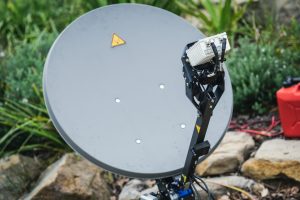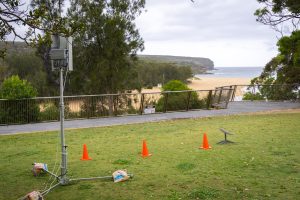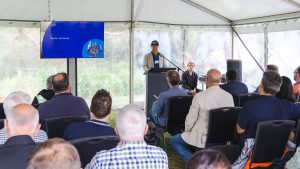A novel Wi-Fi system to enable large-area connectivity in remote and disaster-stricken areas
Connectivity Innovation Network (CIN) has joined forces with the University of Sydney, UTS, and technology partners Pivotel Satellite, NBN Co., OneWeb, and Real Access, to develop a cost-effective large-area Wi-Fi (LAWi-Fi) system for rapid deployment in remote areas and emergency and crisis situations.
In collaboration with NSW Telco Authority, CIN demonstrated the LAWi-Fi system’s capabilities to enable large-area connectivity in emergency and remote areas, enabling efficient communication, coordination, and access to critical resources for first responders and communities.
Under the leadership of Professor Yonghui Li from the University of Sydney and Associate Professor Peiyuan Qin from UTS, the team developed novel LAWi-Fi protocols and multi-beam high-gain antennas. These advancements address the challenges faced by existing Wi-Fi solutions, which are suitable for indoor and close-range scenarios but are often costly for large-area deployment.
“This project represents a major breakthrough in enabling rapid deployment of Wi-Fi systems in crisis situations and remote areas that do not have any internet connections,” said Professor Li. “Our novel Wi-Fi protocol stack and antenna design have significantly extended the reach and performance of Wi-Fi networks, offering a cost-effective solution for large-area deployment.”
A final demonstration of the project was recently held at Wattamolla Beach, Royal National Park, building upon a successful halfway mark. The centralised Wi-Fi protocol proved to be compatible with commercial chipsets, Wi-Fi 6, and older versions, ensuring maximum compatibility and user accessibility.
The system aims to support up to 100 users with a 10Mbps data rate in a 2x2km area, ensuring rapid deployment and efficient outdoor operation capability. The backhaul, provided by Pivotel Satellite, includes LEOsat constellations such as OneWeb and Starlink, as well as NBN Co’s Sky Muster, with the possibility of LTE network integration. An SD-WAN solution supports network bonding and Multi-Path Transport Protocol for essential data transmission. Additionally, the innovative Wi-Fi protocol addresses the hidden node problem, enhancing long-range performance and data rates. UTS-designed high-gain antennas offer wide beamwidth and dual-polarisation for stable data rates regardless of orientation.
“By addressing the hidden node problem and improving long-range performance and data rates, the project sets a new standard for crisis connectivity,” said Associate Professor Qin. “We believe that this technology has the potential to significantly transform disaster response and enhance connectivity in remote areas. Through collaboration and innovation, we can make a positive impact on society.”
The project’s large-area Wi-Fi system has potential practical applications in various industries, including agriculture, remote education, large warehouses, underground mines, industrial settings, and emergency services.













